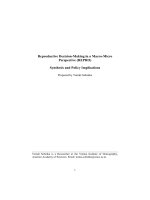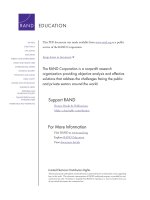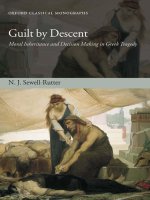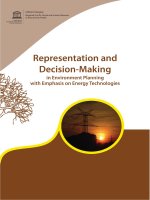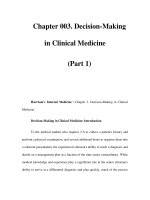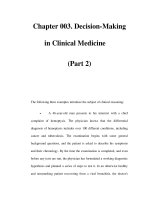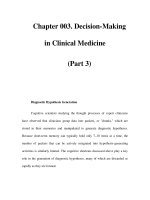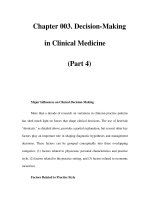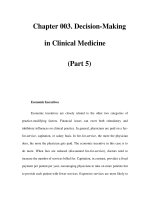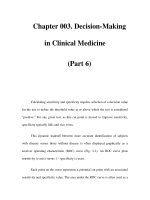Exploring individual decision making in democratic kampuchea, 1975 1979
Bạn đang xem bản rút gọn của tài liệu. Xem và tải ngay bản đầy đủ của tài liệu tại đây (612.74 KB, 132 trang )
BEYOND BLACK UNIFORMS AND WITHERED VICTIMS:
EXPLORING INDIVIDUAL DECISION-MAKING IN
DEMOCRATIC KAMPUCHEA, 1975-1979
JONATHAN BISSON
(B.A. (Hons.), McGill University)
A THESIS SUBMITTED
FOR THE DEGREE OF MASTERS OF ARTS (RESEARCH)
SOUTHEAST ASIAN STUDIES PROGRAMME
NATIONAL UNIVERSITY OF SINGAPORE
2009
Acknowledgements
This thesis represents my first independent research experience, and I owe the
ability to carry it through to the talent and diligence of the dedicated faculty of the
Southeast Asian Studies Programme and other students embarked upon similar academic
journeys. Through their supportive advice and teachings, this period in Singapore and my
fieldwork in Cambodia challenged and enriched my previous perspective of this region.
My parents played an important role in supporting me through all my projects, from the
very beginning. Dr. Erik Kuhonta encouraged me to apply to NUS and advised me to
undertake this research in the Southeast Asian Programme. I owe this unforgettable
experience to his wisdom.
I feel much indebted to Dr. Natasha Hamilton-Hart for guiding me through
confused initial thesis proposals, encouraging the development of my ideas, preventing
me from drifting away from my main focus and making this final project possible. I was
fortunate enough to benefit from her conscientious professionalism and unflinching
intellect. Most of all, I am sincerely grateful for her unwavering trust, which allowed me
to push my own limits and continue through doubts and uncertainties.
I thank Professor Reynaldo Ileto, Dr. Goh Beng Lan, Dr. John Miksic and Dr.
Kyaw Yin Hlaing for initiating me to the fascinating field of study that Southeast Asian
studies represent in its many aspects. I cherished their experience and passion in
ii
broadening my horizons with the pioneers of this field, postcolonialism, archeology and
political science of Southeast Asia.
I also want to thank Ms. Tan Lucy and Ms Rohani Sungib for easing through
bureaucratic obstacles and paperwork, always in unmatched cheerfulness.
I wish to express my gratitude for the funding and institutional support received
since I began this endeavour. In these two years, the generous Research Scholarship
provided by the Southeast Asia Studies Program at the National University of Singapore
necessary to undertake this thesis, and the Graduate Research Support Scheme enabled
my fieldwork in Cambodia.
I cannot thank enough the staff of DC-Cam whose relentless efforts in trying to
unearth information about that difficult period of their history provided most of the
interviews and facts for this thesis. For a period of three months, their welcoming
facilities and professionalism made Phnom Penh feel like home.
Finally, my colleagues of the ‘grad room’ both inspired me and made this
experience as enjoyable as it was enriching. I will always fondly remember how their
unique life experiences taught me far beyond academic matters. Special thanks in
particular to Chhaya for her genuine interest and frank criticism.
iii
Table of Contents
Acknowledgments ............................................................................................................. ii
Statement of Original Research ........................................................................................v
Summary ........................................................................................................................... vi
Chapter1: A Post-Mortem of Cambodia .......................................................................01
Chapter 2: Enter the Khmer Rouge ...............................................................................19
Chapter 3: Shades of Compliance ..................................................................................41
Chapter 4: Resistance: Disobedience and Rebellion.....................................................60
Chapter 5: Escape: Boundaries and Movement ...........................................................81
Chapter 6: The Black Market: The Price of Survival, Desire and Corruption .........99
Conclusion ......................................................................................................................115
Bibliography ...................................................................................................................118
iv
Statement of Original Research
Unless otherwise specified, I declare that this thesis is an original product of
research undertaken at the National University of Singapore under the auspices of the
Southeast Asian Studies Program. I accept complete responsibility for the views, analysis
and representations I have chosen to present in this study. On the date of submission this
thesis comprised of 29,989 words.
Jonathan Bisson
MA. Research Scholar (NUS)
v
Summary
This study explores the different choices taken by members of the Cambodian
society in the traumatic period of the Khmer Rouge Communist regime between 1975
and 1979. My thesis attempts to contribute to the existing scholarship on that period by
amalgamating individual stories into various themes altogether representing the outlines
of a common social history. While the repression and suffering were irrefutable, I argue
that there were some spaces for decision-making through cooperation, negotiation or
resistance to the radical Khmer Rouge government. I chose to survey the whole
Cambodian population without segregating their social background; for that reason, the
main purpose of this thesis was to demonstrate the range of decisions and the complex
relationship between representatives of the state and members of society. My thesis seeks
to reveal that many Cambodians demonstrated insightful observations about their
situation and a resourcefulness that transcends a simple victim/perpetrator binary.
Divided in six chapters, this thesis discusses the different reactions from
Cambodians to certain unilaterally imposed policies from the Khmer Rouge. In Chapter
Two, I discuss the different reasons that motivated the Khmer Rouge soldiers to join the
revolution and demonstrate the heterogeneity of the organization. In Chapter Three, I
survey the necessary cooperative attitudes that were necessary under those circumstances,
but nevertheless varied in their manifestations and did not exclude instances of
disobedience. Chapter Four examines the seemingly opposite stance of disobedience and
resistance against the established order. In Chapter Five, I discuss the Cambodians who
vi
took the decision to flee the Khmer Rouge either internally or externally. Finally, Chapter
Six unveils how segregated social groups, including Khmer Rouge soldiers and officials,
often recreated market conditions despite the rules against private ownership and the
severe punishment associated with a transgression of such rules.
From these different themes, a conclusion arises. These different stories ought to
dispel the notion of passivity of Cambodian society during the Khmer Rouge period.
Despite clear limitations and very high costs, there were still several spaces for individual
choices. Each chapter also addresses the notion that the boundary between the state and
society was not that well-defined, and this reality was possible because the state itself had
limitations in its discipline and reach within its territory.
vii
Chapter 1: A Post-Mortem of Cambodia
After almost two years of tensions and sporadic fighting, Vietnam finally decided
to terminate the Khmer Rouge1 regime in Cambodia in December 1978.2 A few weeks
later, this campaign was already over as 100,000 Vietnamese troops, with the support of
20,000 Cambodian refugees, controlled 17 out of 19 provinces in Cambodia.3 Despite
this definitive defeat, the Khmer Rouge lingered as a fighting force for almost two
decades of irregular warfare. Great powers like China, the United States, and other
Western countries with the assistance of Thailand decided to rebuild the defeated Khmer
Rouge organization to ensure that the latter was able to pursue a disrupting fighting role
in Cambodia against its new Vietnamese masters.4
The scale of the devastation in Cambodia was unfathomable. This devastation was
largely the aggregate result of the recent invasion by the Vietnam People’s Army, the
scorched-earth strategy from the rapidly retreating Khmer Rouge, the previous intense
civil war opposing the Khmer Rouge to the pro-American Lon Nol regime from 1970 to
1975, and the simultaneous massive bombing campaign unleashed by the U.S. Air Force
during the Second Indochina conflict. Still, the main culprit for the landscape of this
devastated country peppered with mounds of bodies and mass graves, half-completed
irrigation projects and a non-existent economy, roads full of trans-migrants and cities
1
Nayan Chanda, Brother Enemy: The War after the War (New York: Collier Books, 1988)
The term Khmer Rouge refers to the Communist Party of Kampuchea active since the mid-fifties. Prince
Sihanouk, head of state between 1954-1970, first coined the phrase. For this research, I will continue using
this term to designate the Communist organization for the sake of simplicity. During the regime, the Khmer
Rouge often designated themselves as ‘Angkar’, literally translated to ‘the Organization.’
3
Rosemary H.T. Keohane, ‘Cambodia in the Zero Years: Rudimentary Totalitarianism,’ Third World
Quarterly, Vol. 14, No.4 (Nov. 1993): 735-748.
4
John Pilger, ‘Return to Year Zero’, New Internationalist, issue 242, April 1993.
2
1
empty of inhabitants was rather the short-lived Khmer Rouge regime, established
officially between April 17th 1975 and January 9th 1979.5
The extensive literature documenting and discussing the Khmer Rouge’s rise and
withdrawal from power is to a great extent preoccupied with the large casualty figures
resulting from the period, with casualties estimated at around two million Cambodians
from an initial population of around eight million.6 The enormous scale of devastation
rapidly captured the focus of international media and academia, which attempted to
tackle a difficult question: why did this happen? The answer came in different packages,
depending on the aspect of the Khmer Rouge under scrutiny: the party’s history, its
ideology, its leaders, its international relations, Cambodia’s historical processes, the
Indochina War or the perpetrators’ cultural rationalizations, to name a few.
The first author to describe and denounce the nature of the Khmer Rouge
revolution was Catholic priest François Ponchaud, who witnessed the forced exodus of
Phnom Penh in April 1975.7 While other articles and books on the regime were also
published in the seventies, the almost complete closure of the country to foreigners made
reliable data collection difficult until the collapse of the regime. Even after the collapse,
the humanitarian crisis and the civil war continued to pose a challenge to scholars and
journalists attempting to describe and explain the major events of the regime.
5
In fact, as most of the countryside was already under Khmer Rouge control from as early as 1972, the date
of April 17, 1975 refers to the significant and symbolic capitulation of Phnom Penh. As for the date of
January 9, 1979, it was determined with the establishment of the Vietnamese-backed ‘People’s Republic of
Cambodia”, although the Khmer Rouge still had de facto control over pockets of territory.
6
The statistics of lives lost to starvation, disease and executions ranged from a low 700,000 to as many as
3.3 million. However, the consensus reached by different methods of calculation hovers at around 2
million. A significant obstacle to these calculations was the fact that the most recent census on population
before the Khmer Rouge dated from 1962.
7
François Ponchaud, Cambodia Year Zero. London : Allen Lane, 1978.
2
As a result, not including the very political stances on the Cambodian situation,
several conflicting hypotheses on the nature of the regime coexisted in the eighties. For
instance, Serge Thion8 described the Khmer Rouge as being unable to control the country
after their empowerment, while Michael Vickery9 qualified the Khmer Rouge revolution
as being more peasant-driven than Communist. Ultimately, years of rigorous data
collection, archival research and in-depth interviews slowly lifted the veil of the elusive
Khmer Rouge and their disastrous reign.
The works of historians David Chandler and Ben Kiernan represent the most
widely-accepted descriptions of the regime. Their seminal books on the Khmer Rouge
regime – Chandler’s The Tragedy of Cambodian History in 1991, and Kiernan’s The Pol
Pot Regime in 1996 – debunked several contentious hypotheses and made the reality of
the Khmer Rouge era more accessible. Those books initially attracted my attention to this
topic, and their research provided both the basis for this research and the opportunity to
explore other aspects of the regime. Decades of debates and research on the Khmer
Rouge apparatus itself yielded a better perspective on the organizations’ leaders and
followers:
The prevailing image of the Khmer Rouges as uniformly mindless automatons,
bent on destruction, was fundamentally wrong. What the deportees themselves
experienced was a mosaic of idealism and butchery, exaltation and horror,
compassion and brutality, that defies easy generalisation. That, too, would
continue throughout the Khmer Rouge years.10
8
Serge Thion. ‘The Cambodian Idea of Revolution,’ in Revolution and it Aftermath in Kampuchea: Eight
Essays, eds. David Chandler et al. Yale University Southeast Asian Studies: New Haven, Conn. 1983: 1033.
9
Michael Vickery, Cambodia:1975-1982, Boston: South End Press, 1984.
10
Philip Short, 2004, Pol Pot: Anatomy of a Nightmare, Henry Holt and Company: New York: 281.
3
If students of that period of Cambodian history reached the consensus that a
regime described as ‘totalitarian’ in fact embedded many inconsistencies in its
governance, it seems logical that the population under its control was able to display
forms of behaviour that defy easy generalization as well. A closer look at published
narratives of survivors of the regime suggests that examples of resourcefulness, deduction
and decision-making also emerge, weaved between tales of suffering and losses. In many
cases, Cambodians commenting on their life under Pol Pot often related with some pride
those daring actions, crucial decisions or insightful observations. Hence, incorporating
those views is necessary to contribute to a more accurate understanding of the regime.
Therefore, this research does not attempt to answer why did so many Cambodians die,
but rather: How did Cambodians adapt to, escape from or manipulate the situation under
the Khmer Rouge regime between 1975 and 1979?
To answer this question concretely calls for the elaboration of a social history of
this period, which would establish the middle ground between studies of the Democratic
Kampuchea state and the myriad of individual stories from survivors of the regime. The
writing of a ‘social history’ in the case of the Khmer Rouge regime requires the delicate
and difficult balance between the acknowledgement of the severe abnormal restrictions
enforced by this totalitarian state and the presence of instances of free will and decisionmaking. At the same time, another difficulty lies in describing different individual
experiences without generalizing them or sacrificing the humanity of the survivors. While
these difficulties are found in the writing of any history, the study of the Khmer Rouge
regime requires particular caution because of the traumatic experience and extreme
sufferings endured by Cambodians of the time.
4
While this thesis does not aim to write a social history of the period, I intend to
pave the way for such an endeavor by studying this period from a perspective that
emphasizes the Khmer Rouge regime as a state-society relationship within certain
parameters. More precisely, I juxtapose the mechanisms employed by the Khmer Rouge
to enforce ideologically inspired policies with the various ways in which Cambodians
responded to the concrete implications of such policies. In doing so, I attempt to grasp the
space where Cambodians chose distinctly divergent options in their responses to the
violence of the regime. For instance, the proliferation of black markets illustrated how
individual needs and resourcefulness nullified the strict Khmer Rouge policies of
eliminating private property and any form of economy.
Methodology and Sources
In order to unearth important patterns, I compiled 129 interviews of Cambodian
survivors from various sources: translated interviews from the Documentation Center of
Cambodia (DC-Cam), published autobiographies by Cambodian readers of the DC-Cambased magazine Searching for the Truth and other published biographies. I carefully read
through these interviews and identified recurrent themes occurring throughout the
country during this period.
I then regrouped related patterns of behavior into five
different sections:
1-Joining the Khmer Rouge apparatus
2-Cooperating with the authorities and obeying the rules of the regime
5
3-Disobeying/confronting those rules
4-Escaping from the control of the Khmer Rouge within or outside the country
5-Negotiating assets and skills in the parallel black market
These categories were not definite nor mutually exclusive: they merely serve to
formulate and emphasize the differences in the actions and decisions taken by
Cambodians during the Khmer Rouge period. Some of those actions could and did
coexist at the same time, and Cambodians often had little time or information to react to
drastic changes in their lives. In the context of the abnormal social relations of this
period, when former social status, identity, relationships and possessions were brutally
disrupted under the latent threat (and execution) of violence, the paramount
preoccupation was survival.
The main source of stories was the Documentation Center of Cambodia, an
archive established by Yale University in 1994 and located in Phnom Penh. From the 129
stories, 88 were collected from this source. They were selected on the basis of available
English translations, and correspond to most of the interviews published during the eight
years of existence of the English edition of Svèng Rok Kapit: Searching for the Truth. In
order to be selected for this thesis, the interviews or biographies had to be at least two
pages in length, as the shorter ones did not provide sufficient information, and also
referred to the story or episode of a single individual. I avoided another possible source in
the translated interrogation files from prisoners of S-21.11 These documents presented
11
The term ‘S-21’ refers to the infamous highest level of security prison located in a former high school in
Phnom Penh and also known as ‘Tuol Sleng.’
6
detailed aspects of each victim’s story, but the method of interrogation under torture and
threat of execution seriously undermines the validity of the stories
The documentation center represents the only archive for the Khmer Rouge
regime and stores thousands of interviews conducted by either their staff or previous
researchers. They subsequently selected a few of these articles for their monthly
publication, Searching for the Truth, established in 2000. From the 88 stories from DCCam, the majority (63) was provided through interviews conducted by their staff. They
compiled these interviews with an open-ended question asking the respondents to explain
their lives during Democratic Kampuchea.12 Such methodology often yielded unexpected
insights and allowed a broader scope of research than leading and precise questions. The
background of the interviewed survivors also offered the most variation from any other
source: several former Khmer Rouge personnel and Cambodians from all the different
provinces were interviewed; hence, an overview of the data presented a complete picture
from different sections of society. The editor of Searching for the Truth, Youk Chhang,
also gracefully accepted to publish letters from survivors sent to the center, thus
providing valuable primary sources. In contrast to interviews, the latter did not require
the interpretation of an interviewer. These autobiographies represented the rest of the
stories obtained from DC-Cam (25).
DC-Cam, founded by Yale University, thus promotes a perspective emphasizing
on the individual role played by the leaders of the Khmer Rouge movement for the
12
‘All interviews are structured to begin with very general questions, such as “what happened to you before
and during the Pol Pot time?” The DC-Cam field research policy is based firmly upon experience that has
demonstrated the importance of avoiding leading questions. We seek to uncover individual responsibility
and command responsibility for genocide, war crimes, crimes against humanity, and the first elements of
these crimes are revealed in the survivors’ stories. Our interview methodology attempts to penetrate every
possible detail that an interviewee can remember concerning what that person observed in the locale where
they were situated during the DK regime.’ Excerpt from DC-Cam’s Annual Report 2000.
7
unfolding of the Cambodian genocide, and the necessity to bring these leaders to an
international court of justice. This explicit goal of pursuing justice in an international
court to prosecute the main leaders of the Khmer Rouge plausibly affected the collection
of interviews by its researchers. While this agenda did not seem to directly affect the
content of the interviews, the stories often ended with a somewhat superimposed
endorsement of international justice from the interviewees. However, the interviewers did
not elaborate on the nature of this endorsement, as survivors of the regime seem to
disagree on how justice should be (or should have been) pursued.
Furthermore, DC-Cam has also assumed the responsibility for museums
commemorating the genocide like Tuol Sleng and the Choeung Ek site outside Phnom
Penh. While DC-Cam has been very active in providing a voice for Cambodians and
facilitating research on the Khmer Rouge for jurists and scholars, it is debatable to what
extent alternative perspectives or dissonant voices could co-exist within this established
framework.
In order to avoid an over-reliance on this sole source, I used biographies and
compilations of interviews of Cambodian refugees published in the United States or
France. Those biographies provided the remaining 39 stories. Furthermore, their authors’
new cultural context compelled them to articulate Cambodian cultural meanings behind
some situations for a Western audience.
However, these biographies overrepresented certain sections of Cambodian
society. In the biographies published in the United States for instance, the majority of
interviewees came from middle-class urban families, while this group actually
represented a minority of the population of Cambodia at the time. Furthermore, refugees
8
accepted in the United States were typically registered from the Khao-I-Dang refugee
camp in Thailand.13 This fact resulted in a geographic bias, since most of these refugees
came from the nearby province of Battambang, leaving other provinces of Cambodia
underrepresented. Most importantly, the stories selected for publication had to correspond
to certain objectives of the publisher. In the United States, many publishers selected
stories for their ‘emotional appeal’, thus overwhelmingly published stories from
Cambodians who were only children during the regime.14 This bias had the adverse effect
of propagating the belief that Cambodians during the regime were helpless or unaware of
the events surrounding them.
Finally, the published biographies from France were important in developing the
ideas set forth with this thesis. Unlike most of their compatriots in America, some of
these Cambodians previously completed their higher education in France, often in
technical fields like engineering. With this background, they had a different perspective
on events and provided some articulate opinions about their experiences. French
publishers also presented stories of these older men engaging the Khmer Rouge with their
insights and knowledge. Therefore, these sources could lead to the opposite
misrepresentation of generalizing the ability to outmaneuver the Khmer Rouge. While
this represents another bias, such detailed stories offer other valuable insights into an
underrepresented section of the Cambodian population, hence contributed to the
articulation of this thesis.
13
14
William Shawcross, The Quality of Mercy, (New York: Simon and Schuster, 1984), 5.
From David Chandler’s Preface to Hour Chea, Quatre Ans avec les Khmer Rouges, (Paris: Tchou, 2007).
9
Research Limitations
Beside the limitations from its sources, this research also has methodological
limitations. First of all, the sample size of 129 interviews, while detailed, remains rather
small to effectively represent the Cambodian population of that period. Furthermore,
these interviews were selected on the basis of their availability, mostly from the DCCam, thus do not represent a truly random sample. A larger random sample from the
complete set of interviews would be necessary to significantly generalize the proportion
of responses.
Although this research respects and values the accounts of every Cambodian, the
respondents also had their own limitations. A few stories could have self-serving
agendas, like in cases of former Khmer Rouge soldiers attempting to polish unpleasant
details from their past employment. In other cases, and perhaps less obviously, the
survivors could have altered the version of their story, either consciously or
unconsciously, as a coping mechanism for the terror of the regime.
Also, the amount of time between the end of the regime and the actual interview
might have varied their perception of the regime, possibly from failing memory. More
generally, their perceptions were likely informed with decades of propaganda and rumors
about the Khmer Rouge government. For example, many interviewees in the United
States consistently referred to the Khmer Rouge soldiers as “Pol Pots”, responding to the
mainstream allocation of responsibility to the leader. Ironically, during most of the
regime, these rank-and-file soldiers ignored the existence of ‘Pol Pot.’
10
The control of information and movement during the regime prevented anyone –
arguably even the leaders of the country – from knowing what was happening nationally,
both from the inside and the outside. In fact, the compilation of stories and documents
from as many survivors as possible is the only way to form a precise picture of events
during the regime.
Due to language restrictions, I am only able to access English or French sources
and access to the more extensive primary Khmer sources was not possible. Translated
materials consequently have their setbacks, particularly when these languages have such
different roots. It is still possible to gather the primary meaning from these cases, but
more subtle expressions and multiple meanings are likely to be lost in translation.
Alexander Hinton’s recent anthropological study of the genocide provides ample
evidence for the wealth of information contained in Khmer words in their original
cultural contexts.
Furthermore, there is no official transliteration of Khmer written words from its
original alphabet to any Western language, which implies that the same word or even a
person’s name can be written quite differently. Unlike many languages in the same
region, spoken Khmer is not a tonal language, but it utilizes complex sounds that are
difficultly translated in another script. Furthermore, the same word can be pronounced
differently within Cambodia due to regional accents and the fact that two different
alphabets, an ‘official’ and a ‘rural,’ coexist. The Khmer words used in this thesis are
simply copied from its sources, and the same word is consistently written the same way.
A peculiar problem in the study of mass murder is the fact that the interviewees
were only the survivors of the Khmer Rouge, hence data about a substantial proportion of
11
the population, the casualties, will never be collected. In this case, the casualties are
estimated to represent as many as 20 percent of the population. Furthermore, if is still
difficult for Cambodians who lived through the regime to fathom the extent of the
tragedy, it is almost impossible for any outsider to simply imagine its magnitude.
Finally, although I took note of the gender of the interviewee or the author of the
story, I did not include an analysis of the effect of gender on the experiences of the
survivors. This omission does not imply that gender is not a significant variable; on the
contrary, a gender-based analysis would require a study on its own, particularly in a
hierarchical and ‘conservative’ society like Cambodia. Regardless of the cultural
background, men and women in any conflict or massacre are treated distinctively. For
instance, men tend to be executed for fear of retaliation, while women, if less targeted for
execution, are often victims of various sexual assault. In that sense, the Khmer Rouge era
was no exception, and a further research on gender based on this framework would duly
anticipate different perceptions and reactions to the regime whether the survivor is male
or female.
Decisions and Parameters
The starting point of this research is the acknowledgement of a space for
individual choices for Cambodians during the Khmer Rouge rule. Is this stretching the
concept of agency too far? While I believe that advancing an argument reclaiming the
role of society in this repressive regime is mostly appropriate and feasible, some
parameters need to be set in place in order to avoid misleading implications.
12
The basic premise is that Cambodians were not merely passive during the three
years of the Khmer Rouge regime. A broad survey of survivors’ accounts would suffice
to prove this point. If we take a group of Cambodians who had to survive the same ordeal
at the same time, we can locate the differences in their thoughts about the situation and
subsequent actions. Therefore, being able to perform different actions in a similarly
repressive situation shows the existence of minimal room for decision-making.
A good example can be found in Ysa Osman’s The Cham Rebellion. In the first
part of his book, the author lists different interviews of Cham villagers who went through
the same ordeal at the beginning of Democratic Kampuchea. Indeed, those Khmer Rouge
survivors were all arrested without having committed a crime and were sent for
interrogation at the Kroch Chhmar prison headquarters in Kampong Cham. Despite the
extent of the coercion, these villagers all reacted differently: a prisoner disobeyed the
rules set by the Khmer Rouge in defiance, another decided to lie during his interrogation
to avoid torture and advised his fellow prisoners to use the same tactic, yet another
decided to stick to the truth and claim his innocence, and the last one attempted to escape
twice during his arrest.15 Those differences illustrate variation even in the most restrictive
situation. From this example, we can infer that Cambodians living outside the prison
system had more freedoms in their decision-making.
Asserting the agency of the subjects of a repressive regime is not tantamount to
displacing the responsibility for their fate from the hands of the guards and soldiers into
their own. In order to avoid any implication of blaming the victim, this research only
looks at which decision was taken and on which premise, without systematically referring
15
El Him’s story, from Osman Ysa, The Cham Rebellion: Survivor’s Stories from the Villages, (Phnom
Penh: Documentation Centre of Cambodia, 2006) 24-44.
13
to the outcome of that particular decision. Avoiding the allocation of blame and
responsibility is intended to prevent passing undue judgment on individuals.
Besides being unethical, linking decisions to outcomes could also be misleading.
Some person’s salvation often proved to be another’s demise. For example, the decision
to undertake the dangerous Thai border crossing cost the lives of many Cambodians, but
it also became the only way for some of them to survive. While some conditions could
explain those different outcomes, according to many survivors themselves, the
determining factor for survival was mostly: luck. Indeed, this un-quantifiable variable
appeared in almost all the survivors’ accounts to explain why they survived a particular
event, while many others perished. In short, this research does not intend to develop into
a problematic ‘survival guide to the Khmer Rouge.’
It is also important to avoid the other extreme of romanticizing the range of
possibilities available in that period. Some survivors’ stories relate complex strategies to
deceive the Khmer Rouge, others offer gripping tales from escape-artists and a few
describe courageous instances of resistance as freedom fighters. Despite the interest
generated by such stories, these examples are exceptions rather than the rule, as most
actions were much more ‘modest’ in nature. There might also be a bias towards such
stories in published accounts. Many biographies and movies about the Khmer Rouge are
focused on a story centered on some ‘heroism’ and may be more appealing in contrast to
the grisly world of such human tragedies. Hence, the set of publications available on the
market sometimes offers an unrepresentative sample of the reality of the Democratic
Kampuchea by overplaying the actual decision-making capacity available to most
Cambodians.
14
Bearing in mind these limitations, this study proposes a context-sensitive
definition of ‘decision-making’. The living conditions will be detailed further in the
course of this thesis, but generally, we can describe Democratic Kampuchea as a
totalitarian regime relying on extensive coercion based on deception rather than an
explicit rule-of-law, in which society was forced to work in different collectivized
economic units mostly related to agricultural production divided on the basis of previous
social class and current age-group. The coercive nature of the state was often concretized
in large-scale executions planned by the higher echelons of the Communist Party of
Kampuchea, although there were many references to personally motivated executions
ordered by local authorities or spontaneous decisions by Khmer Rouge soldiers and
guards. In addition, death often came as a result of unchecked diseases, famine and
overwork, which were linked to varying degrees to decisions by the state authorities.
Chapters
Instead of dedicating a separate chapter for the literature review and the overview
of the regime, I incorporate a specific section of both in each chapter. This division is
aimed at providing the contextual parameters most likely to influence certain actions and
decisions.. For instance, I link the Khmer Rouge evacuation and relocation policies with
escape (Chapter 5), and its policies on the economy (i.e. destruction of currency, market,
prohibition of private ownership) with the creation of an extensive parallel black market
(Chapter 6). This association aims to represent the contrast between intended and brutally
15
implemented policies, and the actual situation emanating from individual decisionmaking.
Furthermore, the attention of previous literature has been unevenly geared toward
certain issues, like the empowerment of the Khmer Rouge and sometimes resistance,
while others have rarely been studied, like the black market and the use of skills during
the Khmer Rouge. The chapters are ordered to follow the most common and arguably
predictable responses, starting with joining the Khmer Rouge and cooperation, to the less
common responses based primarily on the data compiled for this research, namely escape
and the black market.
The second chapter (Chapter 2) examines the processes of recruitment for those
who joined the military and administrative branches of the Khmer Rouge (which were
closely intertwined). The chapter begins with a brief history of the Communist
revolutionary movement in Cambodia, then continues with the five years preceding the
Khmer Rouge capture of Phnom Penh, when most of the recruitment occurred.
Establishing the motives for joining the Khmer Rouge is necessary to appreciate the
differences of objectives within the seemingly monolithic entity of the totalitarian state.
The different expectations from mostly poor rural Cambodians enrolled in the ranks of
the Khmer Rouge can help to explain the disparity of motives witnessed during the
regime itself. Those differences in motives in turn allowed for variations in interactions
between representatives of the state and members of society that will be discussed more
at length in the following chapters.
The next chapter (Chapter 3) examines the most common reaction to the
repression enforced by the Khmer Rouge: cooperation. While this category appears like a
16
euphemism for passivity, some important clarifications justify interpreting some forms of
compliance as an active process for dealing with the harsh reality of the regime. This
omnipresent compliance resulted from the recognition of the threat that the Khmer Rouge
were posing to the lives of their subjects despite the deceptive information disseminated
through propaganda. In some cases, cooperation meant a performance to appear as more
acceptable under the new revolutionary hierarchy. This chapter attempts to highlight
nuances in seemingly straightforward binaries based on identity and in the prevailing
expected reaction to the regime’s cruelty.
Apparently antithetical to compliance were different forms of resistance (Chapter
4). The main reason behind disobedience was the ongoing food crisis triggered by illadvised or faultily implemented economic policies on agriculture. At the individual level,
the necessity to gain more food for personal survival triggered numerous instances of
infringement of rules. On a larger scale, other motives played an important role in more
violent instances of resistance such as assassination plots, confrontations, revolts and
rebellions. However, while those spontaneous outbursts of violence seem relatively
frequent, they had little impact on the conduct of the regime, despite overwhelming
dissatisfaction against it.
The previous behaviors indicated some form of interaction with the ruling forces,
yet in the minds of some Cambodians, were not sufficient to assure safety against the
Khmer Rouge. Hence came the decision to escape the regime altogether (Chapter 5).
Considering the prohibition of internal movement and the reinforcing of border
surveillance, attempting to escape to neighboring countries was a risky and costly
endeavor. Internal displacement, as defined by taking refuge in natural shelters or other
17
villages in Cambodia, was substantially more common, particularly in cases when
executions appeared imminent. Often seeking refuge in a neighboring village or work
camp under the protection of the local village chief was sufficient to provide a shelter
until the end of the regime.
The last chapter (Chapter 6) evaluates the interactions between the new people,
base people and the Khmer Rouge that occurred as a result of local trade and barter.
Contrary to Democratic Kampuchea’s ideals of asceticism and anti-materialism, base
people and lower-level cadre still harbored desires for previously unattainable goods.
These goods were within their reach by trading with new people who had hidden their
valuables and now needed to improve their subsistence. Simultaneously, some Khmer
Rouge cadres found private benefits in utilizing the skills of new people who would
otherwise face harsh discrimination. These interactions partially invalidated the rigid
segregation of classes and officially-enforced hatred propaganda separating the base
people and the new people.
18
